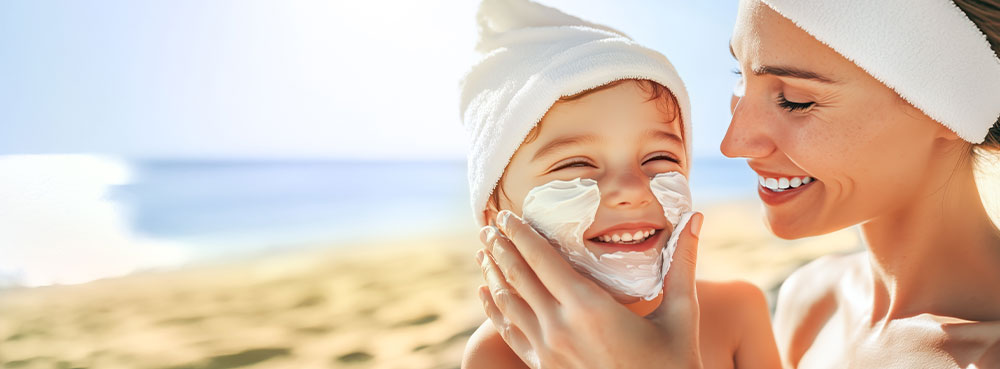Sunscreen Safety in Connecticut: Facts from Local Dermatologists
If you’ve been on Instagram or TikTok lately, you might have seen influencers claiming sunscreen is “toxic” or that their families skip it to “build a tolerance” to the sun. While these sound bites spread quickly, they can be misleading — and when it comes to protecting your skin, misinformation can be dangerous.
The board-certified dermatology clinicians at Dermatology Physicians of Connecticut want to clear up the confusion with facts backed by science, so you and your family can enjoy the Connecticut summer safely. To give patients the clearest answers, we sat down with one of our PAs, Brianna Paesano, MS, PA-C, to address the most common sunscreen myths and share her best tips for year-round protection.
How the Connecticut Sun Can Damage Your Skin
The culprit is ultraviolet (UV) radiation — invisible rays that penetrate the skin, breaking down collagen and elastin (which keep skin firm and elastic). UV rays also damage DNA in skin cells, leading to mutations that can cause skin cancer.
Skin cancer is the most common cancer in the U.S., and Connecticut residents are not immune. Melanoma, the deadliest form, is primarily caused by UV exposure, and childhood sunburns greatly increase the lifetime risk.
Brianna Paesano, MS, PA-C, explains, “Sun damage doesn’t just come from sunburns. Even if you spend much of your day indoors near windows, UVA rays can still reach your skin and cause long-term damage. That’s why daily sunscreen use is so important, no matter the season.”
Can You Build a “Tolerance” to the Sun? Experts Weigh In
Some people believe repeated sun exposure leads to a natural resistance to sun damage. While your skin can tan and thicken slightly, this is actually a sign of injury. Even mild tanning involves DNA damage — some of which is never repaired.
Brianna Paesano, MS, PA-, explains: “The most common myth I hear is: ‘I don’t need sunscreen in the winter or when I’m indoors.’ UVA rays — the ones linked to skin aging and increased cancer risk — can penetrate right through windows. That means your skin is still exposed while you’re driving, sitting near a window at work, or even at home.”
She emphasizes that sun damage doesn’t just come from sunburns: “Over time, that low-level, daily exposure adds up. That’s why I tell patients sunscreen should be a daily habit — just like brushing your teeth.”
How Sunscreen Protects Your Skin
Sunscreens contain UV filters that either absorb or reflect harmful rays before they reach your skin:
- Mineral filters like zinc oxide and titanium dioxide physically block UV rays.
- Chemical filters such as avobenzone and oxybenzone absorb UV radiation.
Many products combine both for broad-spectrum protection.
Why Do People Think Sunscreen Is Toxic?
A 2019 FDA study found trace amounts of certain chemical sunscreen ingredients in the bloodstream after heavy, repeated application. While this sparked concern online, the FDA emphasized there is no evidence sunscreen is unsafe and that the benefits of sun protection far outweigh any theoretical risks.
For those concerned, mineral sunscreens are an excellent choice, as they have minimal absorption into the body. Brianna often recommends them to ingredient-conscious patients: “These use zinc oxide or titanium dioxide. They’re less likely to cause irritation, a great option for people with sensitive skin, and many are labeled as ‘reef-safe’ or ‘non-toxic,’ which provides peace of mind.”
She adds that non-chemical methods are also effective: “UPF-rated clothing, wide-brimmed hats, UV-protective sunglasses, and avoiding tanning beds can all help. The goal is to respect patient concerns while still prioritizing protection.”
Sunscreen Safety Regulations and Ingredient Updates
Regulators worldwide continue to review ingredient safety limits. For example, the UK will reduce allowable oxybenzone levels in full-body sunscreens in 2026. The U.S. FDA is also evaluating certain UV filters. Until then, regulatory agencies, including the FDA and the American Academy of Dermatology (AAD), continue to support sunscreen use, stating that the benefits of UV protection far outweigh any theoretical risks of ingredient absorption.
Debunking Common Sunscreen Myths
- Myth: Sunscreen causes cancer.
Fact: UV rays cause skin cancer — sunscreen helps prevent it. - Myth: Sunscreen blocks vitamin D.
Fact: You can still make enough vitamin D with short periods of sun exposure or through diet and supplements. - Myth: Kids don’t need sunscreen unless it’s sunny.
Fact: “Children’s skin is much more sensitive to UV damage than adults’,” Brianna says. “Even just a couple of serious sunburns in childhood can significantly increase their risk of skin cancer later in life.”
Sun Safety Tips for Connecticut Residents
Whether you’re boating on Long Island Sound, hiking Sleeping Giant State Park, or watching your child’s Little League game, follow these dermatologist-recommended tips:
- Use a broad-spectrum SPF 30 or higher daily.
- Reapply every two hours, especially if swimming or sweating.
- Wear hats, sunglasses, and protective clothing.
- Seek shade during midday hours (10 a.m.–4 p.m.).
Brianna sums it up simply: “If I could share just one tip, it would be this — wear sunscreen every day, even in the fall, winter, and on cloudy days. The sun doesn’t take a season off, and neither should your skin protection.”
Frequently Asked Questions About Sunscreen Safety
Q1: Do I need sunscreen if it’s cloudy?
A: Yes. Up to 80% of UV rays can penetrate clouds, so sunburn is still possible on overcast days.
Q2: What SPF should I use in the summer?
A: Use SPF 30 or higher for daily activities, and SPF 50+ if outdoors for extended periods.
Q3: Is mineral sunscreen safer than chemical sunscreen?
A: Both are safe, but mineral sunscreens are less likely to be absorbed into the bloodstream and are popular for kids and sensitive skin.
Q4: Can sunscreen cause vitamin D deficiency?
A: No. Research shows sunscreen has minimal effect on vitamin D levels.
Q5: Do kids need sunscreen every day?
A: Yes, especially when the UV index is 3 or higher. Childhood sunburns significantly increase melanoma risk.
Q6: How often should I reapply sunscreen at the beach?
A: Every two hours — or immediately after swimming, sweating, or towel drying.
Q7: Where can I get a skin cancer screening?
A: Schedule an appointment with Dermatology Physicians of Connecticut for a comprehensive skin exam and personalized sun safety guidance.
Bottom Line
Don’t let misinformation put your skin at risk. Daily sunscreen use — along with protective clothing and smart sun habits — is your best defense against premature aging and skin cancer.
As Brianna Paesano, MS, PA-C, emphasizes: “It doesn’t have to be complicated. A broad-spectrum SPF 30+ sunscreen or moisturizer each morning is quick, easy, and incredibly effective. The sun doesn’t take a season off — and neither should your skin protection.”
👉 Request an Appointment Today at one of our convenient locations in Branford, Fairfield, Hamden, New London, Oxford, Stamford, Shelton, Norwalk, or New Haven to get fast, effective relief from impetigo and other skin concerns.

Brianna Paesano, MS, PA-C (previously Brianna Butler) is a board-certified physician assistant. Brianna received her undergraduate degree in Allied Health Sciences from University of Connecticut in 2016 where she was Captain of the Soccer Team. She continued her education at Monmouth University where she earned a Masters of Physician Assistant Studies. She is a member of the American Academy of Physician Assistants as well as the Society of Dermatology Physician Assistants.
Brianna’s goal is to help patients achieve and maintain healthy skin. Brianna has experience treating various dermatological disorders. She enjoys treating a wide variety of conditions including psoriasis, eczema, acne, skin cancer detection and more. In addition, she can help you achieve your goals of looking your best with the use of a proper skincare regimen as well as neurotoxins, fillers, micro-needling, and PRP.

